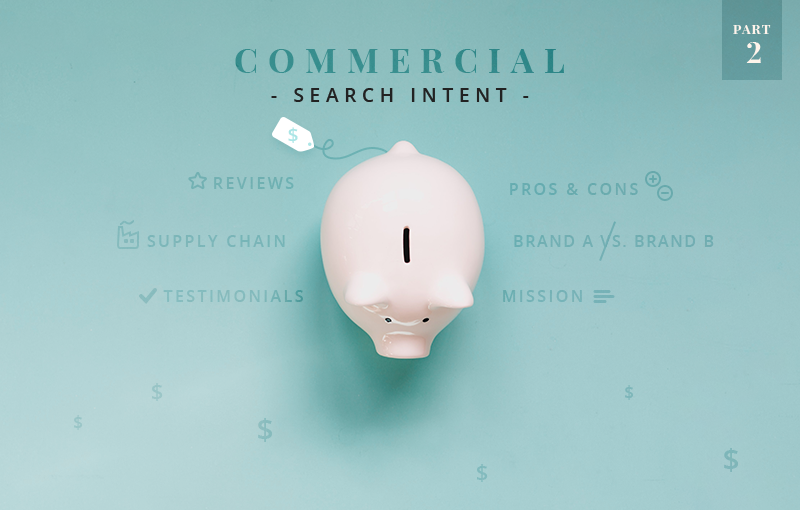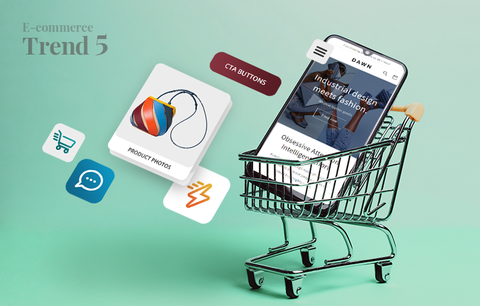
If you want to rank high on the SERPs, optimizing your Shopify store for search intent should be a priority.
There are four types of search intent - informational, commercial, navigational, and transactional. Each of them is an integral part of the customer journey. This is why it’s essential that you optimize your store for each type of search intent.
Two weeks ago we published a guide to optimizing your Shopify store for informational search intent → How To Optimize Your Shopify Store For Informational Search Intent
Today we’ll take a closer look at commercial search intent and how you can optimize your Shopify store for it. In the weeks to come we’ll publish two more blog posts dedicated to navigational and transactional search intent.
What you'll learn today
- What is commercial search intent?
- Why optimizing your Shopify store for commercial search intent is important
- How to optimize your Shopify store for commercial search intent?
What is commercial search intent?
A few examples of queries that show commercial search intent:
- brand A vs brand B / product A vs product B
- which brand is better: A or B / which product is better: A or B
- product A and B: compare prices / product A price / product B price
- brand X pros and cons / product Y pros and cons
- brand X reviews / product Y reviews
- brand X testimonials / product Y what customers say
- brand X about / product Y specifications / product Y fabric / product Y dimensions
- brand X mission
- brand X supply chain
- brand X values
Commercial queries combine two types of search intent - informational and transactional.
In other words, when a query shows commercial search intent, the customer is (usually) past the awareness stage of their journey and is now getting closer to making a purchase.
However, they are still not 100% sure about the brand or the product they chose, i.e. they are still in the consideration stage. Which means that they still need information. Only now they need more specific information and, as a result, their queries are more focused on specific brands or products.
Why optimizing your Shopify store for commercial search intent is important
Think of it like this: when a customer's query shows commercial search intent, the customer is 50% to 90% sure they want to buy from you.
This means that while they were in the early research stage of their journey, they found something about you that they liked. However, they still need to be persuaded that your brand is worth their trust and money. This means that they’ll need a wide range of information about your products (specifications, features, price, reviews, etc.), as well as information about your brand (your values, philosophy, mission, supply chain, etc.) and how it compares to other brands.
So, if you want these hesitant buyers to convert, it is essential that you give them this information. Otherwise, it is very likely that you’ll lose a huge percentage of potential customers.
In other words, optimizing your Shopify store for commercial search intent is at the heart of any successful customer acquisition strategy.
How to optimize your Shopify store for commercial search intent?
Ultimately, when it comes to optimizing your store for commercial search intent, you have one very clear goal: to build trust. Here's what you can do to achieve this:
- Write blog posts optimized for commercial search intent
- Create a “Case studies” page and write case studies that will enhance your credibility
- Add a “Reviews” page to your Shopify store (or feature reviews on strategic places across your website)
- Leverage customer testimonials
- Optimize your “About” page
- Do some off-page optimization for commercial search intent
Let's take a closer look at each of these points.
How to write blog posts optimized for commercial search intent?
In our guide to optimizing your store for informational search intent, we talked a lot about Shopify’s blogging engine and optimizing your content for informational search intent.
Today, we’re going to level up your blog optimization knowledge and talk about another type of content - content, optimized for commercial search intent.
The question at hand is: How can you create such content?
For starters, you can write comparison blog posts - “brand X vs brand Y”, “product X vs product Y”, etc. In other words, write articles in which you objectively (and I cannot stress this enough!) compare your brand to other brands in the industry. To create such a blog post, you need to:
- Agree on a set of attributes which will serve as comparison criteria. For example, availability, accessibility, size, sustainability, price, and value for money, can serve as criteria of a wide range of product comparisons. You can also include other attributes: nutrition (food), aroma (food, hot drinks, candles, etc.), flavor (food, drinks, etc.), material (furniture), fabric (clothing), freshness, specifications, features, and more.
- When you research and define the criteria of comparison, it is best to consult with a market research agency. This will help you remain impartial, i.e. you won’t be tempted to write a blog post based solely on what gives you an edge. Instead, you’ll write a post which compares two (or more) products or brands based on objective criteria. As a result, the overall evaluation will not be biased.
- Remember that such blog posts are not the place to promote your products. In fact, in this case, promotion will undermine your credibility. Which will inevitably have a negative impact on your bottom line. So, it is essential that you remain impartial - stay focused on providing value, not making a sale.
So, this is the informational piece of the commercial search intent optimization puzzle. But, as we already mentioned, commercial keywords suggest transactional search intent as well. And to optimize your content for such intent, you can write articles focused on your products. You can:
- Interview happy customers and publish the interviews on your blog.
- Write articles focused on the features of your products, or the stories of different product lines.
- Write articles focused on the benefits of your products, the problems they solve, etc.
- Write articles that share tips and tricks on how people can make the most of a specific product, and more.
The possibilities are endless! And the best part is that, in this case, the blog posts are all about making customers believe they want and need your products. They are all about making a sale. So, you’re allowed to be biased and brag as much as you want.
Need inspiration? Check medik8's SKIN EXPLAINED →TARGETED SOLUTIONS - the links in this subcategory will give you a pretty good understanding of how a well-written piece of commercial content looks and feels.

How to write case studies that build trust?
Aside from creating blog content that builds you up, you can (and definitely should!) create a “Case studies” page, or add a “Case studies” blog to your Shopify store.
Remember that, when it comes to optimizing your website for commercial search intent, your goal is to do everything in your power to boost your credibility. This is exactly what case studies do - they give potential customers context and help them understand your brand and products better. And, in our human minds, once we can understand something well, we’re more likely to trust it… and, in the e-commerce world, trust = purchase.
There are a myriad of ways to write a case study. And there’s no universal rule… what works for one brand, doesn’t necessarily work for another - it all depends on your voice, your customers (and their needs), as well as your brand identity. So, my advice here is to test… write different types of case studies and find out what works best for you and your audience.
But while there’s no universal rule for the approach you should take, or the writing style, there’s something all case studies have in common: They tell a unique story and highlight a benefit (it could be a feature, or the way the product solves a problem, or something entirely different).
So, your goal here is to find out what makes your product special for somebody and tell the fascinating story of their personal customer journey in an honest and engaging way. So, let yourself listen - listen to customer feedback, pay attention to every word… and if you see something that would make a great case study, ask the customer to collaborate.
Then, talk to the customer. Dig deeper. Find out exactly what your product means to them, how it helps them, how they use it, in what specific ways has it made their lives better or easier, and more. And once you have the whole story (with its unique angle), write a case study tailored to that customer.
Basically, this is how you write case studies that build trust - you look for something special, you make a connection, you stay open to communication, and you get to tell the story of someone's unique experience with your products. If you manage to do this, your products and brand will no longer seem impersonal or vague. On the contrary - they will have a personality; they will be the driving force behind a solved problem or a life, made easier.
Ultimately, each case study you create should be completely different from the case studies that other brands create. But it should also be completely different from all other case studies that you create.
And the reason for this is simple: each customer is different and each customer journey is unique. What your product means to one customer is different from what it means to your other customers. And the whole point of creating case studies is to highlight and celebrate these differences, as well as help other customers imagine what your product could mean to them.
Need inspiration? Branch Furniture has a beautifully designed “Customer Stories” page dedicated to their projects.

Each project has a short description, a nice photo showcasing the products’ best angles, and, if someone wants to hear the whole story, they can do it in one click. It’s simple, functional and elegant. You can take a page out of Branch Furniture’s book and create a similar page featuring case studies dedicated to your most noticeable projects.
If you don’t want to create a separate landing page for your case studies, you can create a blog instead. You can call it “Case Studies”, “Customer Stories”, “Success Stories”, “Our Work”, etc. Sky's the limit!
How to harness the power of product reviews?
Product reviews are one of the most effective forms of social proof. And social proof is one of the most effective ways to build your credibility. This is because our brains are wired to trust a product more, if we know that a number of people have already bought it, used it and liked it.
Simply put, reviews are the go-to virtual advisor of hesitant buyers. Therefore, if you want your Shopify store to be optimized for commercial search intent, you need to add a “Reviews” page (or, at the very least, feature product reviews on strategic places across your website).
You can find a number of product reviews apps on the Shopify App Store that can help you do this. Some of your best options include Yotpo, Stamped.io, Loox, and Judge.me.
Here’s what you need to know about each of these apps
Yotpo (✰4.7, free to install, additional charges may apply) allows you to showcase product reviews and ratings anywhere on your website (including your homepage, category and product pages). You can also use data-driven tools that make it extremely easy for your customers to leave reviews and rate your products, personalize the on-site experience, and more.

Stamped.io (✰4.9, $15-$69/month, free plan available) helps you collect and showcase product reviews, photo and video reviews, checkout reviews, as well as import reviews from Facebook, Messenger, AliExpress, Etsy, Amazon, and Klaviyo. You can also enable customers to comment on the published reviews, filter them by topic, enable social sharing for reviews, display community questions and answers, and more.
The app offers 10+ fully customizable on-site display widgets, including carousel, side drawer, all reviews page, and more.

Loox (✰4.9, $9.99-$99.99/month, 14-day free trial) enables you to easily collect, import and display photo reviews, as well as plain text product reviews. You can also display star ratings on collection and product pages, create a homepage reviews carousel, or create a separate “Reviews” page. In addition, you can add a public response to published reviews, and more.

With Judge.me (✰4.9, $15/month, free plan available) you can collect and display ratings and product reviews (including plain text reviews, photo reviews and video reviews). You can display the reviews in a carousel, create a “Reviews” page, or a floating reviews tab.

Now that we’ve covered product reviews and why they’re important, let’s take a closer look at their fancier (and, sometimes, more persuasive) cousin - customer testimonials.
How to leverage customer testimonials?
Similar to product reviews, customer testimonials are a form of social proof which increases conversions and helps you optimize your Shopify store for commercial search intent. So, it’s important that you leverage them.
Testimonials come in all shapes and sizes, but, usually, they are either cool videos, or short paragraphs that praise your brand and products.
But don’t get me wrong - a testimonial isn’t a vague or an over-hyped message filled with superlatives. In order for a testimonial to be effective, it should be specific. In other words, a great testimonial contains:
- A little bit of information about the person who wrote it (or filmed it). For example, what they do, or how old they are, etc. This gives potential customers context, i.e. it helps them understand who the products could be useful to and whether they fit that profile.
- Information about said person’s problem before buying the product (i.e. the answer to the question why they needed it in the first place), as well as information about their concerns before buying the product (if they had any) and what made them choose your brand over competitor brands.
- An answer to the question how the product made their lives better, as well as information on how long they have been using it, how long they have been your customer, etc.
You can ask any customer for a testimonial. However, the best practice is to ask your best customers. These include your loyal customers, your top-spending customers, the customers with the highest LTV scores, new customers who’ve shared how happy they are with your products on social media… you get the idea!
Once you’ve gathered their testimonials, you should decide where you’ll display them. There are several ways to go about it:
- If a testimonial is more product-focused than brand-focused, you should showcase it on the according product page.
- You can display your best testimonials in a carousel on your homepage.
- You can include them in your case studies, as well as in your product-focused blog posts.
- You can create a dedicated “Testimonials” page - this will help you rank for commercial search intent queries like “<your brand name> testimonials”, “<your brand name> what customers say”, etc. That is, of course, if you properly optimize the titles of these pages for search. Learn more about on-page SEO for Shopify → On-page SEO for Shopify: The Ultimate Guide
All of the apps listed in the reviews section above can help you gather testimonials and feature them on your website.
A few more resources you might find useful → The Persuasive Power Of Testimonials (And How To Unlock Them For Your Business) & Out of the sandbox: 13 Ways To Use The Testimonial Section In Your Shopify Theme
How to optimize your “About” page for commercial search intent?
Another thing you can do to make sure that your Shopify store is properly optimized for commercial intent is to create a detailed “About” page. This will help you rank for commercial queries like “<your brand name> about”, “<your brand name> mission”, “<your brand name> story”, and more. It will also help customers learn more about you, your business and brand, which will build your credibility.
So, the question at hand is: How do you create a well optimized “About” page? Let’s take a closer look at two amazing “About” pages.
Example 1: SAMARA

SAMARA’s “About” page immediately states their brand mission - “No living thing is harmed in the process”. Then, the page explains what the brand offers - elegant vegan fashion products (e.g. purses, wallets) without luxury markups but of the highest quality.
Тheir goal is clearly stated: “to create better fashion, implement more efficient supply chains and use and create more sustainable materials.”
They also talk about the materials they use (e.g. water based PU and Microfiber, apple skins - amazing, I know!), their designs, their team and leadership, and their social impact driven initiatives. And there are incredibly beautiful images across the page!
The takeaway:
- Talk about your brand values and mission
- Say what you offer and what makes it unique. Is it your supply chain, the materials you use, or something else?
- State your goal
- Talk about your social impact, environmental footprint, eco philosophy, etc.
- Talk about the people behind the brand - its leadership and team
- Tell your story in an honest and engaging manner
- Make sure your “About” page has character
- Add beautiful images
Example 2: Warren Steven Scott

Warren Steven Scott’s “About” page gives off an intriguing old-time-newspaper vibe - the design is simple and minimalistic: black font on white background.
The text starts with a few facts about the brand, and then dives right into the story of the designer (which is an amazing approach because, by getting to know the designer, the reader immediately feels closer to the brand - the context makes the brand feel more familiar, and, therefore, more trustworthy). So, the takeaway here? Don’t be afraid to make it personal. In fact, we dare you to try this approach!
Ultimately, use your “About” page to tell your story and highlight what makes you unique.
Bonus tip: If you’re a global brand, or just have a lot to say, you can follow medik8’s example and create an entire “About” section.

Medik8’s “About section” consists of 4 categories:
- OUR CRUSADE where they talk about their unique technologies, original research, their CSA philosophy and their founder, as well as give customers a sneak peek behind the scenes.
- OUR VALUES where they talk about their principles and what goes inside their products. Notice that it immediately becomes clear what the brand values are, i.e. they are professionals who think natural (A/N: Thanks for the inspiration, Apple!), are dedicated to quality, and love to collaborate.
- OUR CHARITY where they talk about their social impact driven projects.
- CUSTOMER EXPERIENCE - an easy way for customers to get in touch with them, get more information about shipping and returns, or become a stockist.
Such “About” sections are an exciting journey customers can embark on - it gives them the opportunity to truly explore a brand and what it’s all about. So, if you have the resources to create such a section, and, of course, can fill it with valuable and interesting information, you should definitely do it. Talk about your brand (values, mission, etc.), your products (supply chain, philosophy, etc.), your story (the story of your business, the story of its founder, etc.), your social impact or environmental footprint, and more.
But ultimately, all you need to do when creating and optimizing your “About” page, is to be honest, entertaining, informative and tailor your “About” page to your brand.
So far, we've covered the on-page SEO aspect of optimizing your Shopify store for commercial search intent. But we’re yet to cover another crucial SEO component - off-page SEO and commercial search intent optimization.
Off-page optimization for commercial search intent: making the case for participating in communities & social groups
The question at hand is: What can you do off-site to optimize your Shopify store for commercial search intent?
As I already mentioned (numerous times), optimizing your store for commercial search intent is all about building trust. And one of the oldest tricks in the book to achieve this is to become a part of a conversation and make sure that your opinion is valued among your peers (or, in this case, customers).
So, the answer to the question above is short and simple: You need to become an active participant in discussions on relevant online communities and social groups.
I’m going to be honest, this will require effort and time. But there’s a simple approach that will help you achieve success.
The first step is to find where your customers hang out virtually. I am talking about Twitter chats, Facebook groups, Instagram lives, Quora discussions, you name it - do your research, make a list of all the “spots” where your customers spend time online and become a part of their conversation.
Then, once you’ve been a part of their community for a while and have already built your credibility, you can start discussions on your own. You can talk about your products and brand, you can ask people to share their feedback, their experience, concerns, thoughts, and more.
For example, you can host a live Q&A video on Instagram and answer all sorts of questions about your brand and products. If you see that this strategy works for you, you can do it every week and dedicate each live video to a different topic… it could even go beyond your own business. You can talk about your industry, or more customer-focused topics. You can collaborate with influencers, or other brands, you can host customer interviews, and much more.
The same “all in” approach can be applied to Twitter chats and Facebook groups. You’ll just have to adjust it to the according social media channel. But with persistence and a lot of work, you can definitely utilize each and every channel your customers spend their time on.
"How will this pay off?", you may ask. The bottom line is that community discussions help hesitant buyers make up their mind. The more people talk about you online (and share positive feedback), the more likely hesitant buyers are to think that your brand is worth their trust and money. And, if they see that you’re an active participant who’s open to communication, they’ll trust you even more.
Wrap-up
Commercial search intent is associated with the consideration stage of the customer journey. In other words, when a customer’s query shows commercial search intent, it usually means that the customer is past the awareness stage, but is still not 100% sure that your brand or product is the right choice.
This means that when it comes to optimizing your Shopify store for commercial search intent, your goal is to build trust. You can do both on-page and off-page optimization (for commercial search intent).
On-page optimization consists of creating content (blog articles) optimized for commercial search intent, creating a “Case studies” page, showcasing reviews and testimonials on strategic places across your store (either on product pages, category pages, your homepage, or on dedicated landing pages), and optimizing your “About” page.
Off-page optimization consists of being an active member of relevant social media communities and groups.
We hope this guide will help you achieve all this. If you have further questions or want to share your experience, just leave a comment below!
And stay tuned for the other articles of the “search intent” series - next, we’re going to tackle navigational search intent.



